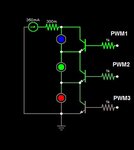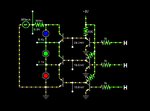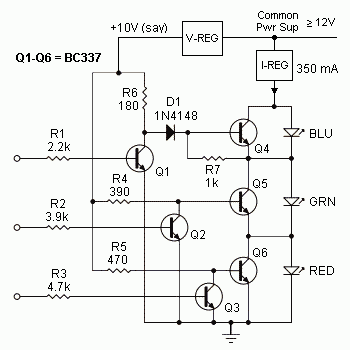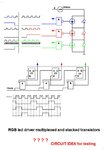NuNDoe
Junior Member level 1
I'm designing a RGB LED circuit that uses a stacked transistor topology. There are 3 LEDs, and each LED is paired with a transistor in parallel... these 3 LED/transistor pairs are stacked together and connected to a constant current driver. To turn on any LED, its corresponding transistor is turned off, so all current flows through the LED. To turn an LED off, the corresponding transistor is turned on, effectively shunting the current away from the LED.
so the question is, with this stacked transistor topology, is there an easy way to control the 3 transistors using logic level outputs from a microcontroller? what additional circuitry do I need to transfer the logic level (5V) output to something that can turn on/off even the transistor at the very top?
with the constant current driver, one can see the voltage at the top LED may vary, depending on how much LEDs are turned on, at most it will be the Vf's of all 3 LEDs, and at a minimum, it will all be shunted to 0V. therefore, the collector voltage of each transistor may also vary...
my initial idea was to have another transistor or mosfet tied to a higher voltage (like 12V input) and driving that with logic and feeding the 12V onto the base of the transistor... however, fluctuations of the input voltage may also effect the brightness of the LEDs...
thanks!

so the question is, with this stacked transistor topology, is there an easy way to control the 3 transistors using logic level outputs from a microcontroller? what additional circuitry do I need to transfer the logic level (5V) output to something that can turn on/off even the transistor at the very top?
with the constant current driver, one can see the voltage at the top LED may vary, depending on how much LEDs are turned on, at most it will be the Vf's of all 3 LEDs, and at a minimum, it will all be shunted to 0V. therefore, the collector voltage of each transistor may also vary...
my initial idea was to have another transistor or mosfet tied to a higher voltage (like 12V input) and driving that with logic and feeding the 12V onto the base of the transistor... however, fluctuations of the input voltage may also effect the brightness of the LEDs...
thanks!



